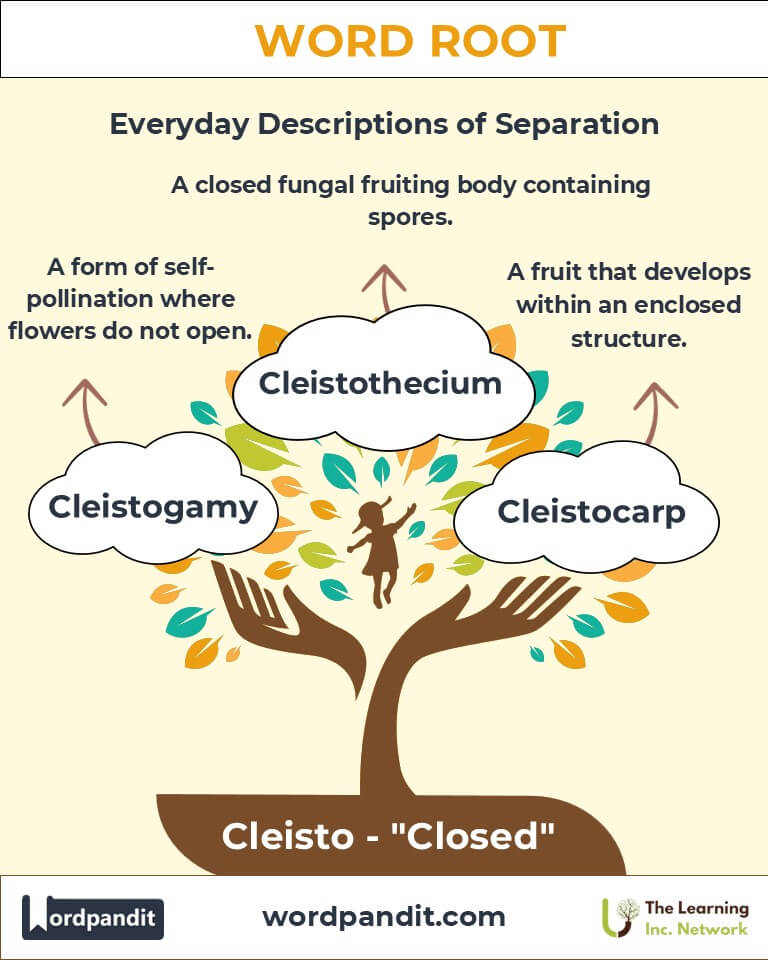Cleisto: The Root of Closure in Language and Nature
Discover the fascinating world of "Cleistos," a root derived from Greek, meaning "closed." From biological processes like cleistogamy to microscopic structures such as cleistothecium, this root captures the concept of enclosure and its significance in science and linguistics.

Table of Contents
- Introduction: The Meaning Behind Cleisto
- Etymology and Historical Journey
- Mnemonic: Unlocking the Power of Cleisto
- Common Cleisto-Related Terms
- Cleistos in Specialized Fields
- Illustrative Story: Cleisto in Action
- Cultural Significance of Cleisto
- The Cleisto Family Tree
- FAQs About the Cleisto Root
- Test Your Knowledge: Cleisto Mastery Quiz
- Conclusion: The Closed Legacy of Cleisto
1. Introduction: The Meaning Behind Cleisto
Pronounced "klees-to," the root cleisto emerges from Greek, meaning "closed." It forms the basis of terms describing enclosed or self-contained phenomena, particularly in biology. Words like cleistogamy, where flowers self-pollinate without opening, and cleistothecium, a protective fungal structure, highlight its importance in understanding natural processes of preservation, security, and autonomy.

2. Etymology and Historical Journey
Cleistos stems from the Greek word kleistos, translating directly to "closed" or "shut." In ancient Greek culture, the concept of enclosure often symbolized protection and privacy. Over centuries, this root became prominent in scientific terminology, particularly in botany and mycology, as researchers observed self-contained reproductive systems and protective structures in plants and fungi.
3. Mnemonic: Unlocking the Power of Cleisto
Imagine a flower tightly closed, shielding its inner workings from the outside world. This self-contained image is a perfect mnemonic for the cleisto root.
Mnemonic Device: "Cleistos means closed, like a door keeping secrets inside."
4. Common Cleisto-Related Terms
- Cleistogamy (klees-tog-uh-mee): A form of self-pollination where flowers do not open.
Example: "Cleistogamous plants ensure reproduction even under adverse conditions." - Cleistothecium (klees-toh-thee-see-um): A closed fungal fruiting body containing spores.
Example: "The cleistothecium protects fungal spores until conditions are suitable for dispersal." - Cleistocarp (klees-to-karp): A fruit that develops within a closed or enclosed structure.
Example: "The cleistocarp is a rare but fascinating adaptation in certain plants." - Cleistogean (klees-to-jee-an): Relating to plants or flowers that exhibit cleistogamy.
Example: "Cleistogean traits are common in plants thriving in extreme climates." - Cleistogenetic (klees-to-jen-et-ik): Pertaining to closed reproductive processes.
Example: "Cleistogenetic systems minimize dependence on external pollinators."
5. Cleistos in Specialized Fields
- Botany: Cleistogamy plays a critical role in ensuring plant reproduction in adverse environments where pollinators are scarce.
- Mycology: Structures like cleistothecium protect fungal spores, enabling their survival and dispersal in harsh conditions.
- Evolutionary Biology: Cleistogamous adaptations reveal strategies of self-reliance and energy conservation in reproductive biology.
6. Illustrative Story: Cleisto in Action
In a remote desert, botanist Dr. Elena observed an intriguing wildflower. Unlike others, it never bloomed outwardly. Upon closer study, she discovered it was cleistogamous, self-pollinating to conserve water and energy. This unique adaptation inspired Dr. Elena's research into sustainable crop breeding, proving how the concept of "closure" can lead to resilience and innovation.
7. Cultural Significance of Cleisto
The idea of enclosure, as symbolized by cleistos, resonates in various cultures. Ancient Greeks used the concept to represent protection and self-reliance. Similarly, in modern contexts, the principle of cleistogamy reflects the value of independence and adaptability, traits revered in both nature and human endeavors.

8. The Cleisto Family Tree
- Claus- (Latin: Closed): Clause: A section in a document, "closed" in meaning.
- Sphinct- (Greek: Tightened or Closed): Sphincter: A muscle that closes an opening in the body.
- Seg- (Latin: Cut Off): Segregate: To separate or set apart.
10.FAQs About the Cleisto Word Root
Q: What does the root "cleisto" mean?
A: The root "cleisto" originates from the Greek word kleistos, meaning "closed" or "shut." It often describes enclosed or self-contained systems in biology and related fields, symbolizing independence and protection.
Q: What is cleistogamy?
A: Cleistogamy is a reproductive strategy in which flowers self-pollinate without opening. This ensures reproduction in adverse conditions where external pollinators like insects or wind are unavailable. Plants like violets and peas often exhibit cleistogamy.
Q: What is a cleistothecium?
A: A cleistothecium is a closed fungal fruiting body that encloses spores, protecting them from environmental stress until conditions are favorable for dispersal. This adaptation is crucial for fungi living in challenging habitats.
Q: How does cleistogamy benefit plants in extreme environments?
A: Cleistogamy helps plants conserve resources by avoiding the energy-intensive process of attracting pollinators (e.g., producing nectar or colorful petals). It ensures reproductive success even in harsh or isolated environments.
Q: How does cleisto highlight the concept of independence in nature?
A: Terms derived from cleisto emphasize self-sufficiency, such as cleistogamy, where plants pollinate themselves without relying on external factors. This reflects how nature adapts to ensure survival under restrictive or isolated conditions.
Q: Are cleistogamous plants less diverse genetically?
A: Yes, cleistogamy often results in reduced genetic diversity since the plants rely on self-pollination. However, this trade-off is offset by the increased likelihood of reproductive success in environments where cross-pollination is unreliable.
Q: What is the primary role of cleistothecia in fungi?
A: Cleistothecia protect fungal spores by enclosing them in a tough, sealed structure. This adaptation is especially beneficial in environments with fluctuating or extreme conditions, ensuring the spores' survival and eventual dispersal.
Q: How does cleistogamy differ from chasmogamy?
A: Cleistogamy involves self-pollination within a closed flower, while chasmogamy refers to open flowers that rely on external agents, such as insects or wind, for pollination. Many plants exhibit both strategies for flexibility.
11.Test Your Knowledge: Cleisto Word Root Quiz
1. What does the root "cleisto" signify?
2. Which term describes self-pollinating flowers that do not open?
3. What is a cleistothecium?
4. Why is cleistogamy advantageous in extreme climates?
5. Which field primarily uses the term cleistothecium?

11. Conclusion: The Closed Legacy of Cleisto
The root cleisto beautifully encapsulates the concept of closure and its biological significance. From flowers that thrive in seclusion to fungal structures safeguarding spores, it highlights the elegance of self-reliance and adaptability in nature. As we continue to study these closed systems, the cleisto root reminds us of the ingenious strategies life employs to endure and flourish.











